PinotFile: 9.20 February 26, 2013
|
In Pursuit of Balance: A Discriminating Goal
Ted Lemon, Littorai
Balance is offered as a high accolade whenever the quality of wine is discussed. It represents a subjective perception of harmony between all of a wine’s components that produce aromas, flavors and haptic characteristics of taste, including acid, sugar, alcohol, tannin, fruit extract, oak and texture, with no one element dominant. With over 300 chemical constituents in wine, it is impossible to analytically arrive at a determination of balance. We are left with our personal taste to ascertain balance and therefore quality in a wine. It is a personal aesthetic that is hard to describe, but we know it when we experience it. In the words of winemaker Ted Elliott, “If a wine tastes great, yet you can’t describe it, it’s in balance.” An organization, In Pursuit of Balance (IPOB), was launched three years ago to promote dialogue about the importance and the challenges of achieving balance in California Chardonnay and Pinot Noir. Founded by American sommelier Rajat Parr, Wine Director for the Michael Mina restaurant group and owner of Sandhi Wines, and Jasmine Hirsch of Hirsch Vineyards, the organization’s stated intent is to support wineries who are striving to produced balanced Pinot Noir and Chardonnay in California. The implied goal is to offer an alternative to the strong voice and ubiquitous presence in the marketplace in recent years of California wines of prodigious size (often referred to as butterball Chardonnays and Parkeresque Pinot Noirs). The wineries in IPOB are poised to show a different style of California wine, an “Ode to Burgundy,” if you will, that is not proclaimed to be superior to other styles (although this is easily inferred), but aimed at receiving recognition of another option. The emphasis is on food-friendly wines that are site-driven. The idea is to avoid leaving grapes to hang to reach extreme ripeness. This invariably leads to an escalation of alcohol percentage and wines that are manipulated out of necessity, resulting in a loss of all expression of site. One can argue that wines do not have to be site specific to be good and the average consumer doesn’t really give a damn whether the wine reflects a defined terroir. However, the consumers of the types of ultrapremium wines offered by producers included in IPOB do care, much like the flock of Burghounds who seek out wines from Burgundy that truly reflect their origins. One can also assert that prodigious wines, although maybe relinquishing some vineyard and vintage character, can be in balance and not completely outliers. Ted Lemon has told me, “Both powerful and delicate wines can be balanced. Neither has cornered the market on wine balance.” This contentious issue is often tied to alcohol percentage. Many powerful wines are high in alcohol, and some believe that a wine above 15% alcohol, for example, cannot be balanced. Allen Meadows has said as much. On the other hand, low alcohol is no guarantee of balance either. When I surveyed most of the wines offered for tasting at this event, most of which were from the admittedly cool 2010 and 2011 vintages, I found a majority of the Pinot Noirs had alcohol percentages in the 13.0 -13.8% range, with only two wines at 14.5% and 14.6% alcohol. The organizers of IPOB emphasize that alcohol levels are not the central issue, but clearly wines with low to moderate alcohol levels fit the IPOB paradigm best. This discussion can be endless, but the overriding point among the wineries chosen to participate in IPOB is that balance and style are intertwined and the style of the wine will often dictate the possibility of balance.
In Pursuit of Balance recently held two events in San Francisco (February 4, 2013) at Bluxome Street Winery
and in Los Angeles (February 6, 2013) at The London Hotel. Two seminars were offered, “Relevance and
Purpose in California Chardonnay,” and “Exploring Whole Cluster Fermentation in Pinot Noir.” For the first
time, consumers were invited to the seminars. The San Francisco seminars were videotaped and are available
for viewing on the IPOB website (www.inpursuitofbalance.com). I recorded the audio from the two seminars in
Los Angeles I attended with my trusty iPhone and they are posted here (turn up the volume for best clarity): "In Pursuit of Balance"
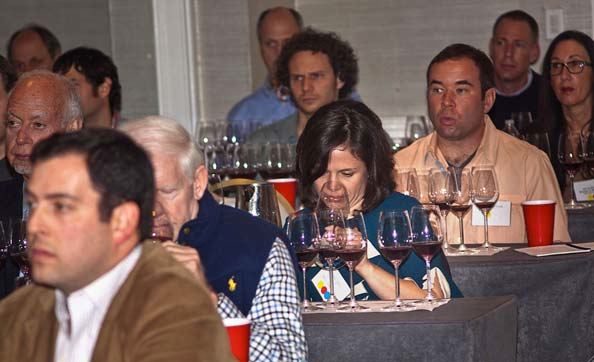 I found the IPOB seminars and tasting to be one of the best events of its kind I have ever attended. The seminars were interesting, informative and challenging. The tasting venue on the roof of the hotel was perfect, with wineries spread out, a modest number of attendees, a superb assortment of California Chardonnays and Pinot Noirs and easy access to winemakers. All the photos are courtesy of Bob Dickey, a Santa Barbara-based photographer whose website is www.winecountrypics.com.
Relevance and Purpose in California Chardonnay
The panel spoke of the current third wave of Chardonnay producers. The first early California style was modeled after Burgundy, the second was the popular “big and buttery or fat Elvis” style that evolved in the 1990s that was largely winemaker driven, and the third most current wave represented by site-conscious producers returning to a semblance of the early California style but drawing on modern viticulture and winemaking techniques. The essential points made during the seminar and themes that the winemakers participating in In Pursuit of Balance share in their preferred vinification of California Chardonnay:
• A belief that Chardonnay is a profound vehicle for expressing terroir.
The wines offered for tasting were all superb:
• 2010 Chanin Bien Nacido Vineyard Santa Maria Valley Chardonnay Fruity aromas and flavors, clearly
California, yet with a bright crispness and refreshing citrus-imbued finish.
Exploring Whole Cluster Fermentation inPinot NoirPanelists (left to right): Jim Clendenen, winemaker Au Bon Climat, Jamie Kutch, owner and winemaker Kutch Wines, Ehren Jordan owner and winemaker Failla Wines, and moderator, Jordan McKay, writer.
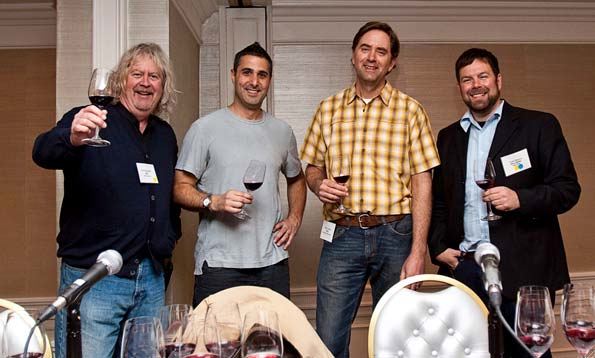 Wine production has its trends, and a trend receiving considerable notoriety currently is whole cluster fermentation. Whole cluster fermentation refers to the fermentation of intact clusters of grapes as they are picked from the vine with no intervention of machine processing, leaving all berries and stems intact. Traditionally, red winemaking begins with de-stemming to remove the grapes from the rachis (the part of the stem which holds the grapes) using a mechanical crusher/de-stemmer. The stems are often removed in Pinot Noir winemaking before fermentation since the stems have a high tannin content, and when unripe, they can contribute green aromas and flavors due to extraction of 2-methoxy-3-isopropylpyrazine which is reminiscent of green bell peppers. With Pinot Noir, even if the clusters are de-stemmed, the grapes are usually not crushed, and are put into fermenting bins at least partially as whole berries to elevate the aromatic profile through partial carbonic maceration (fermentation within the grape coincident with fermentation of the juice which seeps out of the grape). With whole cluster fermentation, this carbonic maceration is even more exaggerated since the berries enter the fermentation bin whole. The Burgundians have practiced stem inclusion in Pinot Noir for centuries, as historically they had no de-stemmers. Today, there are notable domaines that are still advocates of whole cluster fermentation including Domaine Dujac and Domaine de la Romanee-Conti, but many Burgundians now de-stem. De-stemming Pinot Noir grapes in California has been controversial over the last fifteen years since its use fell out of favor with the arrival of modern de-stemmers. The essential points brought out in the seminar about whole cluster fermentation of Pinot Noir are summarized here. The seminar did not dwell extensively on the downside of whole cluster fermentation since all the panelists were champions of this technique, but they did point out many of the potential pitfalls.
• Many of the greatest, most compelling, and seductive Pinot Noir wines are made with this technique.
Each winemaker provided two wines for tasting:
• 2005 Au Bon Climat Bien Nacido Vineyard Historical Vineyard Collection Santa Maria Valley Pinot
Noir 50% whole cluster. Very ripe, dark berry and plum flavored. Not particularly notable.
Twenty-eight wineries participated in this year’s IPOB event. Originally, in 2011, the wines were chosen for IPOB by Parr and Hirsch who looked for wines aligned stylistically in their show of food friendliness and balance. This year, Parr stepped aside (he still participates in the tasting but does not vote) and formed a committee consisting of Failla winemaker Ehren Jordan, wine writer Wolfgang Weber, and San Francisco Chronicle Wine Editor Jon Bonné. The committee tasted the submitted wines blind and arrived at twenty-eight recommended participants for 2013. The list is below with some wines that made a special impression on me (I did not taste wines from every producer). Anthill Farms Winery, Co-owners and winemakers Webster Marquez and David Low, www.anthillfarms.com. Arnot-Roberts, Co-owners Nathan Roberts and Duncan Meyers, www.arnotroberts.com. Bluxome Street Winery, Winemaker Webster Marquez and General Manager Jennifer Velasquez, www.blusomewinery.com. Calera Wine Company, Owner and winemaker Josh Jensen and National Sales Manager Marta Rich, www.calerawine.com. Ceritas, Owner and winemaker John Raytek, Owner Phoebe Bass, www.ceritaswines.com.
Chanin Wine Company, Owner and winemaker Gavin Chanin (below), www.ChaninWine.com.
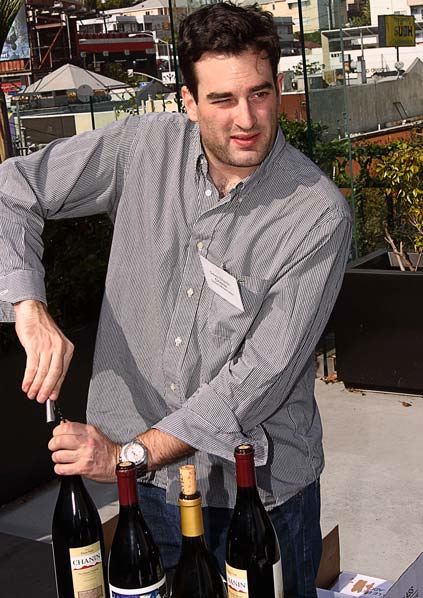
Cobb Wines, Owner and winemaker Ross Cobb, www.cobbwines.com.
Copain Wines, Owner and winemaker Wells Guthrie, General Manager Tony McClung, www.copainwines.com.
Drew Family Cellars, Owner and winemaker Jason Drew, www.drewwines.com.
Failla, Owner and winemaker Ehren Jordan, www.faillawines.com.
Hirsch Vineyards, Owner David Hirsch, Winemaker Ross Cobb, Sales Jasmine Hirsch
Knez Winery, Owner Peter Knez, Winemaker Anthony Filiberti, www.knezwinery.com
Kutch Wines, Owner and winemaker Jamie Kutch, Owner Kristen Green, www.kutchwines.com.
La Rue Wines, Owner and winemaker Katy Wilson, www.laruewines.com.
LIOCO, Owner and winemaker Kevin O’Connor, Owner Matt Licklider, www.liocowine.com.
Littorai, Owner and winemaker Ted Lemon, Owner Heidi Lemon, Assistant winemaker John Wilson,
www.littorai.com.
Mount Eden Vineyards, Owner and winemaker Jeffrey Patterson, Owner Ellie Patterson,
www.mounteden.com.
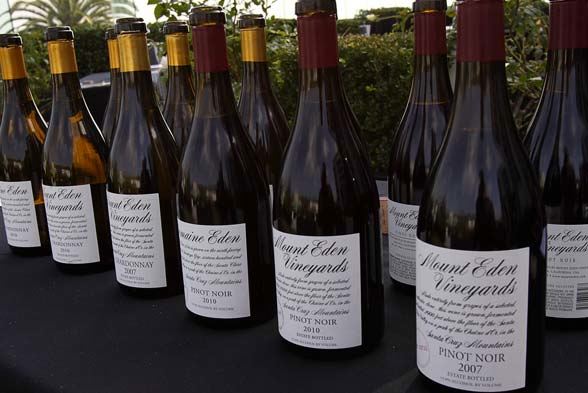
Native9, Owner James Ontiveros, www.native9wine.com.
The Ojai Vineyard, Owner and winemaker Adam Tolmach, www.ojaivineyard.com. Peay Vineyards, Owners Andy and Nick Peay, www.peayvineyards.com.
Red Car, Winemaker Carroll Kemp, General Manager Peter Willmert, www.redcarwine.com.
Sandhi Wines, Winemaker Rajat Parr, Sales Director Stephen Janes, www.sandhiwines.com.
Soliste, Proprietors Claude Koeberle and Donald Plumley, www.soliste.com.
Twomey, Winemaker Ben Cane, www.twomeycellars.com.
Tyler Winery, Owner and winemaker Justin Willett, www.tylerwinery.com.
Varner, Owners Bob and Jim Varner, www.varnerwine.com.
Wind Gap, Owner and winemaker Pax Mahle, Sales Director Susan LaRossa, www.windgapwines.com.
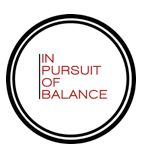 My parting comment is that I really like the style of wine that IPOB champions. However, I am not a slave to any one iron clad Pinot Mystique. We should embrace all styles of Pinot Noir, finding purpose and charm in them all, without insisting that Pinot Noir adamantly adhere to traditional roles.
Latest Gems from the Russian River Valley
Wherever that river goes that’s where I want to be Ballad of Easy Rider, Byrds The Russia River Valley and River are named for Russian explorers who settled at Fort Ross, just north of Jenner, where the Russian River empties into the Pacific Ocean. The Pomo Indians were the original inhabitants of the Sonoma Coast and the Russian River Valley, and named the Russian River Shabakai or “long snake,” for its many twists and turns. The Russians adopted their own name for the river, Slavianka, or “pretty Russian girl.” By 1867, the Russians had left North America entirely, leaving behind the anglicized names Russian River Valley and Russian River as their legacy.
 The Russian River is 105 miles in length, snaking its way from its origins in the coastal mountains near the town of Willits in Mendocino County, progressing through the Alexander Valley, before reaching the Russian River Valley. Just below the town of Healdsburg, the river takes a turn to head west toward the Pacific Ocean. This area is called the Middle Reach of the Valley, a sweet spot for Pinot Noir, and the birthplace of modern Pinot Noir viticulture in the valley. The defining feature of the Russian River Valley is a single three-letter word: fog. Fog from the Pacific Ocean is the most important single influence on viticulture here and it defines the boundaries of the Russian River Valley appellation which was established in 1983. The fog enters the valley during the growing season from the Southwest through the Petaluma Gap between Pt Reyes and Bodega Bay, with a smaller incursion traveling inward along the Russian River from its exit into the ocean at Jenner on the Sonoma Coast. Plenty of daytime warmth (the Russian River Valley is a Region III climatically on the UC Davis scale) gives way to cool nights and mornings caused by the fog. The result is slowed ripening and extended hang time for grapes. The winegrowers here like to say that they turn fog into Pinot Noir.
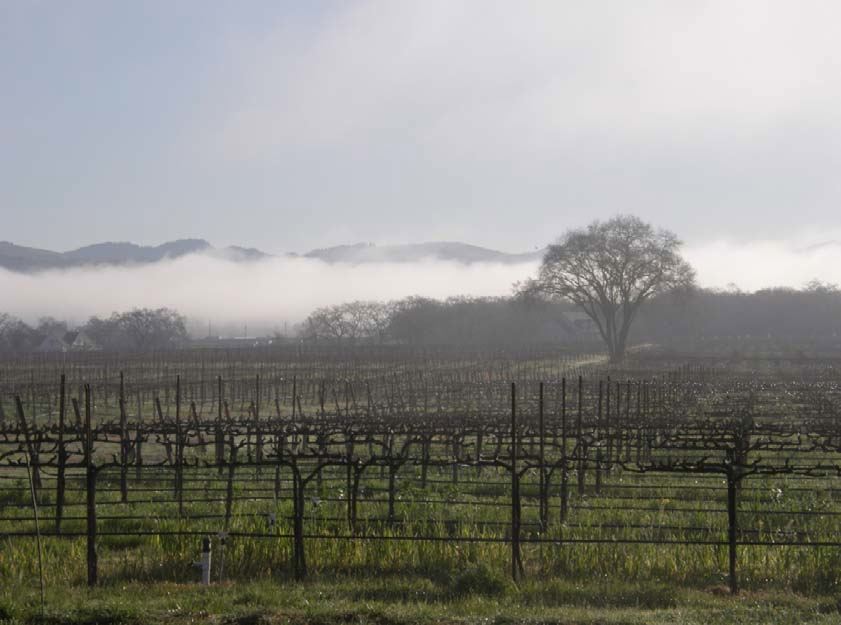 I recently tasted a number of excellent Chardonnay and Pinot Noir wines from the Russian River Valley from the 2010 and 2011 vintages. There is plenty to be thankful for. A few additional wines are included from other regions where a producer also sources outside the Russian River Valley.
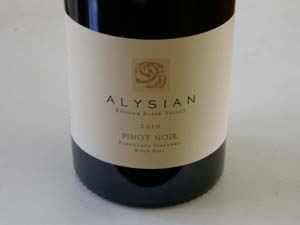 2010 Alysian Floodgate Vineyard Rock Hill Russian River Valley Pinot Noir 13.3% alc., pH 3.39, TA 0.69, 158 cases, $55. Dijon clone 777. Average Brix at harvest 22.8º. 100% de-stemmed. Combination of wild and cultured yeast fermentation. MLF fermentation in barrel. Aged 10 months in 40% new and 60% one and two-year-old French oak barrels. · Moderate reddish-purple color in the glass. Very shy nose initially, opening slowly to reveal aromas of red cherries, cranberries, dried rose petals and grassy oak. The cherry, red berry and red plum stuffing really explodes on the mid palate, finishing with great intensity and nervy acidity that makes the drinker want another sip. Very easy, seamless drinking. The wine gets better over time in the glass - always a good sign - and was even more aromatic and flavorful the following day from a previously opened and re-corked bottle. Not the power of the 2009 vintage, but a beautiful reflection of the cooler 2010 vintage. Gary Farrell is a winemaker you can bank on every vintage to make superb wines that are intensely flavorful, yet bright and crisp and very food friendly - just the way Pinot Noir is meant to be.
2010 Alysian Hallberg Vineyard Crossroads Russian River Valley Pinot Noir 13.5% alc., pH 3.39, TA 0.66, 156 cases, $55. Dijon clone 777. Average harvest Brix 23.6º. 100% de-stemmed. Combination of wild and cultured yeast fermentation, MLF fermentation in barrel. Aged 12 months in 40% new and 60% one and two-year-old French oak barrels. · Medium reddish-purple color in the glass. Shy, slowly evolving aromas of dark berry jam and complimentary oak. Mid weight tasty flavors of blackberries, plum sauce and cola, robed in modest dusty tannins, and brought into focus with bright acidity, and finishing with a long dark-fruited finish with a citrus undertone. Very well crafted and reflective of the cool vintage. Even better the following day from a previously opened and re-corked bottle. This is a terroir-driven wine displaying the dark fruited character that is the signature of this vineyard. Very good (+).
2008 Alysian Cresta Ridge Vineyard Taurin Block Russian River Valley Chardonnay 14.1% alc., pH 3.47, 378 cases, $38. I opened a bottle of this wine recently that was first reviewed in November 2010 and I still find it compelling. 50% MLF in barrel. Aged 10 months in 40% new and 60% one and two-year-old French oak barrels. · Light straw color in the glass. Crisp and flavorful, balanced and refreshing. This wine sings with aromas of citrus fruits and baked pear, echoed on the palate with additions of pale caramel, brown butter and the right touch of oak. Drinking perfectly now and as fresh as it was upon release. Should be good to go for another five years at least.
2010 Alysian Westside Farms Clone 4 Russian River Valley Chardonnay 14.0% alc., pH 3.38, TA 0.72, 158 cases, $40. 100% barrel fermented, 35% MLF in barrel. Aged 7 months in 35% new and 65% one and two-year-old French oak barrels. · Light straw color in the glass. A nose of interest with aromas of Meyer lemon curd, grilled peach, lychee, cream soda and almond. Green apple and lemon-lime flavors with a complimentary hint of nuttiness and toasty oak. Almost steely with grippy acidity that leaves a high-strung, operatic finish. This acid-driven wine reflects the cool vintage. Can be an excellent food wine, particularly with white fish in a butter or cream sauce or goat cheese. Good.
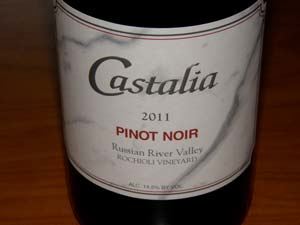 2011 Castalia Rochioli Vineyard Russian River Valley Pinot Noir 14.5% alc., pH 3.55, 300 cases, $55 (6 and 12 bottle lots sold through the website order form). Released February 2013. Twentieth vintage of Castalia Pinot Noir crafted by Rochioli cellarmaster Terry Bering. Yields were 50% of normal in 2011. 50% Rochioli Vineyard River Block and 50% from a 20-year-old block of the West Block clone planted in another vineyard on Westside Road together with some Rochioli Estate wine. Aged 15 months in 20% new French oak barrels. · Moderate reddish-purple color in the glass. Very bright spicy cherry aroma which builds in intensity over time in the glass. Ornate cherry flavor with accents of Chinese five-spice, cola, anise and oak, caressingly soft tannins, finishing with hi-tone cherry presence and a juicy acidity. Also tasted from a bottle opened the previous day and the wine showed more body and nuance suggesting that cellaring for at least a year is advised. Try this wine with Cherry Cordial M&Ms - it really works! Very good.
Coterie Cellars is an urban winery in the San Francisco Bay area. Owner and winemaker Kyler Loudon has studied viticulture and enology at UC Davis. Kyle and his spouse and business partner Shala, were originally part of a coterie of winery workers for two highly regarded wineries in the San Francisco Bay area. They began making wines under the guidance of these and other winemakers while establishing relationships with quality vineyards. The winery is located just south of downtown San Jose. Grapes are sourced from prestigious vineyards in the Russian River Valley and Santa Lucia Highlands. The letterpress labels feature a simple grape cluster and six grape berries as a node to the Gang of Six, with whom they made some of their earliest wines before Coterie Cellars was founded in 2007. The wines are sold through a mailing list and online through the winery’s website store at www.coteriecellars.com. I found the wines well crafted in a fruit-driven style. The wines are generally juicy with modest tannins and good acidity that is more evident in some bottlings. There is a noticeable oak presence in all wines which benefited from opening and re-tasting the next day. The 2010 wines were released July 8, 2012.
2010 Coterie Cellars Saralee’s Vineyard Russian River Valley Pinot Noir 14.5% alc., 174 cases, $38. Clones 113 (50%) and 23 (50%). Aged 11 months sur lie in 48% new French oak with minimal racking. Unfined and unfiltered. · Moderately dark reddish-purple color in the glass. Initially the nose is quite appealing with bright aromas of black cherry and plum, spice and mesquite, revealing some stem and pungency over time. Medium bodied flavors of darker berries and plum with a thread of green oak, earth and flowers. The wine was more appealing on the nose and in the mouth the following day from a previously opened and recorked bottle, yet still had a noticeable presence of smoky oak in the background. It would be interesting to revisit this wine in a year or two. Good.
2010 Coterie Cellars Trenton Station Vineyard Russian River Valley Pinot Noir 14.5% alc., 46 cases, $38. Clone 37 (Mt Eden) from the Old Barn Block. Aged 10 months sur lie in 50% new French oak with minimal racking. Unfined and unfiltered. · Moderately dark reddish-purple hue in the glass. Aromas of ripe black cherries with oak-driven scents of straw, tobacco and brioche in the background. Intensely fruity on the palate with a sappy core of black cherry, and red and black berry fruits, caressed by balanced tannins, finishing with a uplifting riff of cherry tempered by a subtle citrus note. Even better the following day from a previously opened and re-corked bottle. Best to cellar this wine for at least a year to allow better integration of oak and full expression. Good (+).
2010 Coterie Cellars Kirk Williams Ranch Santa Lucia Highlands Pinot Noir 14.5% alc., 113 cases, $35. 50% each Pommard and 667. Aged 10 months sur lies in 50% new French oak barrels with minimal racking. Unfined and unfiltered. · Moderately dark reddish-purple in the glass. Scent of dark berry mash, black cherries and a whiff of espresso. Crisp, modest core of dark red and black fruits underlain with hints of coffee-scented oak. Balanced tannins and some length on the finish. Perfectly fine, but too much oak on board. No change the following day from a previously opened and re-corked bottle. Good.
2009 Coterie Cellars Tondre Grapefield Santa Lucia Highlands Pinot Noir 14.5% alc., $37. Joe Alarid is the grower. 50% each Pommard 4 and 667. Aged 10 months sur lies in 45% new French oak barrels with minimal racking. Unfined and unfiltered. · Moderately dark reddish-purple hue in the glass. This wine veers to the very ripe-fruited zone featuring black cherry, blackberry, prune and black current flavors with non intrusive oak in the background, finishing with good acidity and an appealing spiced black cherry riff. Good (+).
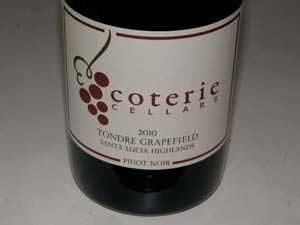 2010 Coterie Cellars Tondre Grapefield Santa Lucia Highlands Pinot Noir 14.7% alc., 147 cases, $37. Pommard 4 and 667. Aged 10 months sur lies in 45% new French oak barrels with minimal racking. Unfined and unfiltered. · Medium reddish-purple color in the glass. The nose offers a perfume of dark berry jam, plum sauce and oak, becoming more expressive over time in the glass. Dark red berries are the featured theme backed by modest tannins and lively acidity. Oak is nicely integrated. I like this wine for its acid-driven vibrancy. Even better the next day from a previously opened and re-corked bottle. Very good.
DuMOL is proudly marking seventeen years with the release of the 2010 vintage wines. Winemaker and viticulturist Andy Smith (pictured below), who marked his fourteenth vintage at DuMOL with these releases, describes the wines as follows: “There’s a great deal of fruit richness and density on offer in all of these wines, but that’s not the vintage’s calling card. It’s the incredible freshness, vibrancy and liveliness they show that really drives the year’s signature.” Andy notes that 2010 was a record cool growing season in the Russian River Valley and a year where considerable attention had to be paid to the vineyards from day one. He gushed about this vintage: “From my perspective, 2010 is our greatest vintage across all vineyards, all varieties and all wines.” If you are a mailing list customer of DuMOL, you know of the full-color booklet that is published and distributed with each vintage release, carefully and exhaustively composed by Andy with extensive, colorful descriptions of the vintage and detailed information including cellar and tasting notes on each of the individual wines. There is nothing comparable offered by any other California winery.
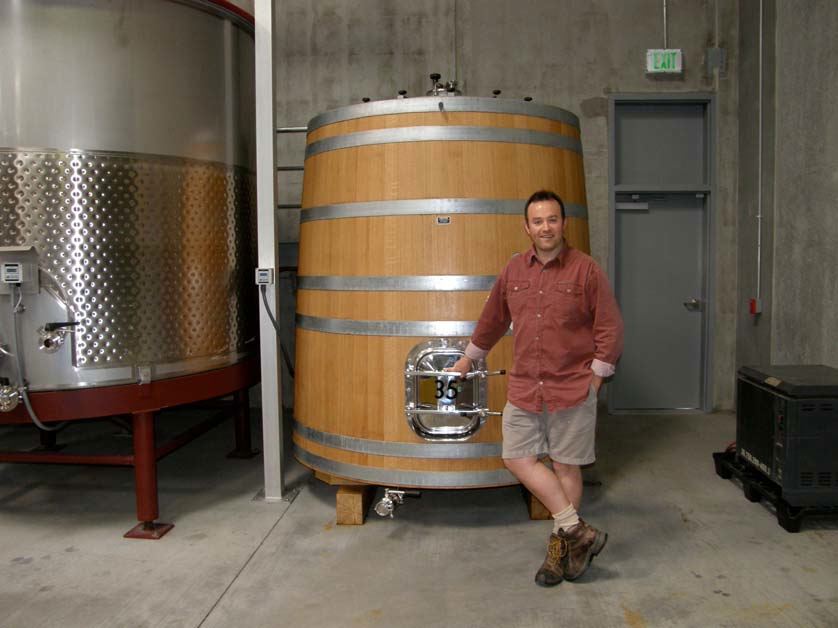 DuMOL wines are allocated through a mailing list with very limited retail distribution. The wines are all vinified with native yeast and malolactic fermentation and bottled unfiltered. The Chardonnays are all barrel fermented after whole cluster pressing. Harvest Brix for Pinot Noirs ranged from 23.9º to 24.6º and for Chardonnay 22.8º to 23.8º. All the wines are quite aromatic, especially over time in the glass, finish with clarity and purpose, and most importantly, are very food friendly. The best drinking window for these wines is 2013-2020 for Pinot Noir and 2013-2017 for Chardonnay. Visit the website at www.dumol.com.
2010 DuMOL Estate Russian River Valley Pinot Noir 14.1% alc., 787 cases, $84. Released November 2012. Sourced from DuMOL Estate Vineyard, Calera, Swan, Pommard, 667 and 777. Yield 2.1 tons per acre from 6- year-old vines. Aged 14 months in 55% new French oak barrels. · Moderately dark reddish-purple color in the glass. Evocatively nuanced aromatic profile offering an array of scents including black cherry, dark berry, forest floor, baking spice, oak cask and old wallet. Moderately rich and very flavorful with intense flavors of black plum and dark berries with an earthy undertone and a hint of spice and vanilla. The attention-getting mid palate attack is followed by a lengthy fruit-driven finish. Well-structured tannins give the wine substance and balance the powerful fruit. Probably the most intensely fruity wine in the 2010 lineup. A muscular ballet dancer. Very good.
2010 DuMOL ryan Russian River Valley Pinot Noir 14.3% alc., 1,184 cases, $78. Released November 2012. Sourced from Widdoes Vineyard, Martini selection. Yield 2.65 tons per acre from 25-year-old vines. Aged 14 months in 45% new French oak barrels. Aged 14 months in 40% new French oak barrels. · Moderately dark reddish-purple color in the glass. Slow to open in the glass, but offers considerable appeal over time. Aromas of fresh blackberry tart, forest floor, rose petal, oak and saddle. Discreetly concentrated core of black raspberry and black plum fruit with a hint of spiced chocolate and vanilla wafer. The tannins and acidity are nicely integrated and the mouth feel is very soft, creamy and sexy. Very good.
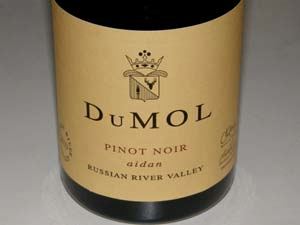 2010 DuMOL aidan Russian River Valley Pinot Noir 14.2% alc., 455 cases, $78. Released November 2012. Sourced from the 3-acre Wildrose Vineyard, 115 and 777. Yield 2.5 tons per acre from 11-yearold vines. Aged 14 months in 40% new French oak barrels. · Moderately dark reddish-purple hue in the glass. Shy, but pleasing aromas of darker cherries and berries with complimentary toasted oak and a floral note. On the palate this wine sings with juiciness and vibrancy, offering delicious blackberry, black cherry and spice flavors. A complete wine with balanced, supple tannins, a seductively soft mouth feel, and a lengthy finish that is bursting with fresh, vivid fruit.
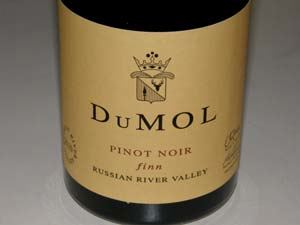 2010 DuMOL finn Russian River Valley Pinot Noir 14.1% alc., 371 cases, $84. Released November 2012. 58% DuMOL Estate and 42% Occidental Road vineyards, multi-clonal field blend. Yield 2.2 tons per acre from vines that are 6 to 16 years old. Aged 14 months in 60% new French oak barrels. · Moderately dark reddish-purple color in the glass. The wine bursts from the glass with effusive aromas of fresh Bing cherries, Chambord liqueur, dried cranberry, spice and bay leaf. A delicious wine that brings all your senses to attention. Flavors of ripe strawberry, blackberry jam, and anise with an earthy, mineral-bound underbelly. Juicy, with lively acidity, perfectly integrated oak, and noticeable length on the finish. Very easy to cozy up to.
2010 DuMOL eoin Sonoma Coast Pinot Noir 14.1% alc., 468 cases, $78. Released November 2012. Sourced from Sonoma Stage Vineyard, Calera and Swan selections. Yield 1.95 tons per acre from 10-year-old vines. Aged 14 months in 40% new French oak barrels. · Medium reddish-purple color in the glass. Aromas of loamy earth, berry pie glaze and dried herbs. A modicum of intensity with flavors of black plum, blackberry, boysenberry and a sidecar of spice. The most savory, earth-bound and tannic Pinot Noir in the lineup, more in the Carneros vein. Very good.
2010 DuMOL eddie’s patch Russian River Valley Syrah 14.2% alc., 1,050 cases, $78. Released June 2012. A 3-vineyard blend from Hoppe-Kelly, Greywacke and Gregori vineyards. Clone 7, 8776, Estrella and Alban. Yield 2.5 tons per acre from vines that are 5 to 13 years old. Harvest Brix 24.4º. Aged 16 months in 33% new French oak. · Dense purple color in the glass. Shy aromas of blackberries, prune, and forest floor. Full-bodied flavors of spicy plum and dark berries with a base of iron-driven minerality and earth. Balanced dry tannins and some persistence on the finish. As a Pinot Noir lover, it doesn’t match up, but is a nicely crafted wine. Good.
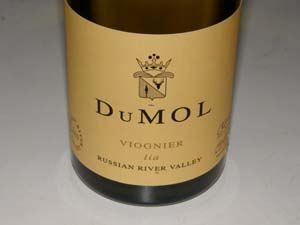 2010 DuMOL lia Russian River Valley Viognier 14.7% alc., 375 cases, $50. Released November 2011. A 3-vineyard blend from Dutton-Gregori, Hoppe-Kelly and Trenton Station vineyards. Clone 1. Yield 1.75 tons per acre from vines that are 7, 9 and 12 years old. Whole cluster pressed, barrel fermented in 20% new and 70% neutral French oak barrels, and 10% stainless steel barrels. Aged on lees for 9 months. · Medium straw color and clear in the glass. Quite aromatic, with scents of tropical fruits including dried mango and guava, lemon curd, ginger and brioche. An Alsatian style wine with a delicious core of tropical fruits including grilled pineapple with an appealing sidecar of toast, honey, nuts and vanilla. Slightly creamy in texture, finishing with aplomb and focus. Terrific!
2010 DuMOL Estate Russian River Valley Chardonnay 14.3% alc., 460 cases, $60. Inaugural bottling released November 2012. Sourced from the DuMOL Estate Vineyard, Wente “Hyde” selection and Mt Eden selection. Green Valley district of Russian River Valley. Yield 2.5 tons per acre from 5-year-old vines. Complete malolactic fermentation land aging 15 months in 40% new French oak barrels. · Light straw color and clear in the glass. Aromas of lemon curd, golden apple, almonds and flint stone. Beautiful marriage of fruit (peach, lemon) and oak (subtle vanilla and nuttiness). Bright, finishing on a refreshing citrus-driven high note that lasts. Very good.
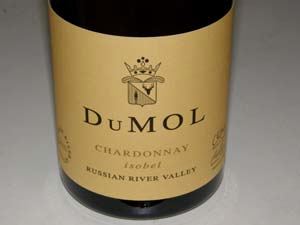 2010 DuMOL isobel Russian River Valley Chardonnay 13.9% alc., 955 cases, $60. Released November 2012. Sourced from Charles Heintz Vineyard, UCD 108. Yield 3.5 tons per acre from wines that are 29 years old. Complete malolactic fermentation and 15 months aging in 40% new French oak barrels. · Light straw color and clear in the glass. Very fresh scent of lemon, grilled peach, pear and savory herbs. Remarkable palate presence with impressive energy and a vibrant lift of acidity on the extended finish. The peach, lemon and nutty flavors are complimented by a touch of caramelized oak and really grab your attention. Very flavorful, but has the balance and restraint to pair beautifully with food. Heintz Vineyard Chardonnay is my paramour.
2010 DuMOL chloe Russian River Valley Chardonnay 14.2% alc., 1.130 cases, $60. Released November 2012. Sourced from Ritchie Vineyard, Wente selection. Yield 3 tons per acre from 38- year-old vines. Complete malolactic fermentation and 15 months aging in 50% new French oak barrels. · Light straw color and clear in the glass. Very expressive nose, offering aromas of lemon blossom, tangerine, croissant and almonds. Soft in the mouth, with plenty of pear, white peach and lemon flavor augmented by minerality. Faint toasty oak frames the wine which leaves a lingering impression on the finish. Did I mention the marvelous mouth feel?
2010 DuMOL clare Carneros Chardonnay 14.3% alc., 642 cases, $60. Released November 2012. Sourced from Hyde Vineyard, Wente “Hyde” selection. Yield 3 tons per acre from vines that are 16 years old. Partial malolactic fermentation and aging for 15 months in 50% new French oak barrels. · Light straw color and clear in the glass. Very shy aromatically, offering demure aromas of white peaches, citrus blossom and fresh brioche. A slightly steely style, with a tasty core of peach and citrus zest, framed by beautifully integrated oak. The mineral-driven, citrus-toned finish is lasting. This wine doesn’t make a huge impression on me, due to a personal stylistic preference, but it is very well crafted and satisfying. Very good.
The 2010 and 2011 vintages of George Wine Company Pinot Noir are sold out. George prefers all lower case on his website and label so it is in reality, george wine company, but he often calls his winery george pinot noir just to keep you alert. Quantities were very limited. No winery in California has more presence on well-regarded restaurant wine lists in the United States than george. Think of Restaurant Guy Savoy, STK and Joel Rubicon in Las Vegas, CUT in Beverly Hills, Gordon Ramsey in West Hollywood, Angelini Osteria in Los Angeles, and Tocqueville, Le Cirque and Jean Georges in New York. See the full list on the website. George Pinot Noir is quite the cult wine and I have been a fan from the beginning. George is one of the few wineries in which I have tasted every wine in every vintage (dating to 2003). George is basically a one-man show with George Levkoff performing every step of winemaking from sorting to hand numbering every bottle, managing marketing and sales personally and often delivering wine as well. The wines are highly allocated to an eager mailing list with past customers given priority at www.georgewine.com. Some of the 2010 wines were revisited recently and the 2011 vintage wines are reviewed for the first time. 2011 was the coolest summer in memory in the Russian River Valley. George harvested his grapes in late September before the unseasonable premature rains came in early October. He is a disciple of Burt Williams and his wines reflect that homage.
2010 george Vintage VIII Sonoma Coma Russian River Valley Pinot Noir 13.9% alc., 195 cases, $50. A blend of Ceremonial, Hansen and Leras Vineyards. · Deeply perfumed nose of black cherry pie glaze. Mid weight flavors of black cherries, dark red berries, cola and spice with a moderately firm tannic backbone and some finishing intensity. Has gained some power since last tasted almost a year ago. Good (+).
2010 george Vintage VIII Hansen Vineyard Russian River Valley Pinot Noir 13.9% alc., 195 cases, $60. A terroir-driven wine that is quite distinctive. This vineyard sits next to a dairy farm and has a smell and taste of cow waste which many find very appealing, including many sommeliers. · Medium reddish-purple color in the glass. Aromas of black cherries, dark chocolate, toasty oak, sweet smoke, and barnyard. The wine has a signature smoky, fecal note in the background with middleweight fruit flavors of dark cherries and raspberries. Well-crafted with mild but adequate tannins and good uplifting acidity. Not my preferred cup of tea but I can respect it for what it is. Good (+).
2011 george Vintage IX Sonoma Coma Russian River Valley Sonoma County Pinot Noir 13.5% alc., 299 cases, $50. · Medium reddish-purple color in the glass. Shy cherry aromas with a prominent contribution of smoky, toasty oak. Juicy flavors of raspberries, cherries and cola with a mild tarry, barnyard riff probably reflecting the contribution of Hansen Vineyard. Welcoming balance with easy drink ability, picking up more fruit interest over time in the glass. I prefer the 2010 vintage of this wine. Decent.
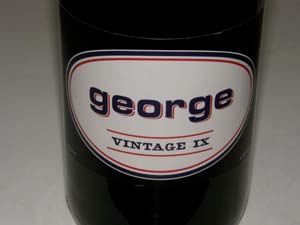 2011 george Vintage IX Ceremonial Vineyard Russian River Valley Sonoma County Pinot Noir 13.9% alc.,157 cases, $60. · Medium reddish-purple hue in the glass. Enticing aromatic presence with scents of fresh black cherries, dark currants and spice. Delicious core of moderately rich dark red berry, plum and black cherry flavors with complimentary notes of spice and cola. Well-balanced tannins, focused acidity, and a very appealing crisp and juicy finishing note like biting into a fresh, cold, plump cherry. Very admirable effort in a difficult vintage.
 2011 george Vintage IX Leras Family Vineyard Russian River Valley Sonoma County Pinot Noir 13.3% alc.,199 cases, $60. · Moderately dark reddish-purple color in the glass. A terrific expression of Pinot Noir with hi-tone aromas of fresh, spiced black cherries and a discreetly concentrated core of black cherry and black raspberry flavors. The nose really makes you stop and take notice. Very approachable with gentle tannins and a good cut of acidity on the citrus-hued finish. There is a very slight vegetal note in the background, reflecting some lack of ripeness. Still the wine is a beautiful expression of the vintage and Very good.
2010 J Vineyards & Winery Estate Grown Russian River Valley Pinot Noir 14.4% alc., pH 3.74, TA 0.56, 9,300 cases, $37. Released September 2012. A blend of grapes drawn from some or all the ten estate vineyards. 100% de-stemmed, aged 15 months in French oak. · Medium reddish-purple color in the glass. Aromas of cherry cordial, raisin (cooked fruit) and vanilla. Middleweight flavors of chocolate-kissed cherries with hints of cola, rhubarb, marzipan and vanilla. Very approachable with mild tannins and plenty of luscious, Russian River fruit character, although some vibrancy is missing from a lack of acidity. Decent.
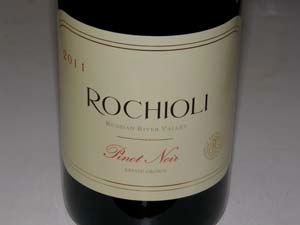 2011 Rochioli Estate Grown Russian River Valley Pinot Noir 14.5% alc., $54. Primarily sourced from Sweetwater Vineyard and includes new West Block plantings. Aged 15 months in French oak barrels. · Moderate reddish-purple color in the glass. Big, effusive nose of ripe Bing cherries. Medium weight flavors of dark red cherries with accents of cola, oak vanillin and loamy earth in the background. A real crowd pleaser with that signature Middle Reach luscious cherry fruit, but tempered nicely by balanced tannins and acidity to make a complete wine that finishes bright and juicy. Very good.
2011 Rochioli Estate Grown Russian River Valley Chardonnay 14.5% alc., $42. 70% Mid 40 and 30% River Block vineyards. 100% MLF. Aged sur lie for 9 months. · Light straw color and clear in the glass. Very shy white peach, Meyer lemon, vanilla wafer and toasty oak aromas. Flavors of lemon curd, pineapple and white peach with a hint of smoky oak in the background. Fresh with a bright cut of underlying acidity. Good.
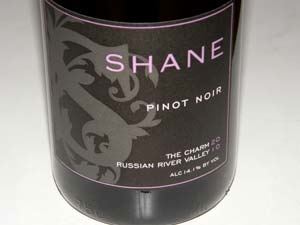 2010 Shane The Charm Russian River Valley Pinot Noir 14.1% alc., 225 cases, $45, sold out. Vinified by Shane Finley, the winemaker at Lynmar and former assistant winemaker at Kosta Browne. The Shane wines are sold through a mailing list. · Moderately dark reddish-purple color in the glass. Lovely aromas of fresh Bing cherries with a touch of exotic spices. Moderately rich core of perfectly ripened black cherries with complimentary hints of cola, edible flower, earth and oak in the background. The very long and intensely fruity finish lasts at least 30 seconds. Very forward and charming as the name would imply. I really enjoyed drinking this marvelous example of Russian River Valley Pinot Noir.
Ten Acre Winery offers limited production cool-climate Pinot Noir and Chardonnay from the Russian River Valley and Sonoma Coast. Owners Scott and Lynn Adams acquired their first estate vineyard in 1995, and established Bella Vineyards & Wine Caves specializing in limited production Zinfandel and Rhone wines in 1999. Since 2002, they have lived with their daughters on a 10-acre vineyard in the Middle Reach of the Russian River Valley, just two miles from the vineyards of Rochioli who has been an inspiration for Ten Acre. The vineyard manager for the sites they work with is noted viticulturist Charlie Chenoweth and the winemaker is Pinot Noir and Chardonnay specialist Michael Zardo. He has a degree in enology from Fresno State University, and spent seven years as an assistant winemaker at Pisoni Vineyards & Winery.
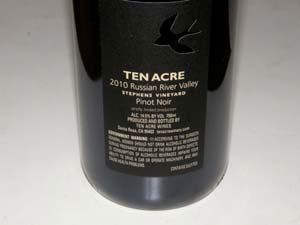 2010 Ten Acre Earl Stephens Vineyard Russian River Valley Pinot Noir 14.5% alc., pH 3.82, TA 0.55, 190 cases, $55. Clones 115, 667, 777 and Pommard from a vineyard planted in 1999 in Goldridge soil. The wine was aged 12 months in 40% new French oak barrels. · Moderately dark reddish-purple color in the glass. A cherry-fruited nose draws you into the glass. Delicious Bing cherry core with complimentary riffs of cola, sassafras and spice. The oak is well integrated, and the copious fruit is tempered nicely by enough ripe fruit tannin to create a mouth-coating experience. Quintessential Russian River Valley Pinot Noir. Very good.
2010 Ten Acre Green Acre Hills Sangiacomo Sonoma Coast Chardonnay 14.3% alc., pH 3.55, 250 cases, $48. Sourced from a vineyard planted in 1991 at a cool, coastal influenced mountain location. Yields 1.5 to 2 tons per acre. Aged 11 months sur lie with barrel stirring in 40% new and 60% neutral French oak barrels, 100% MLF. · Light straw color and clear in the glass. Fresh aromas of lemon zest, baked pear, kiwi, graham and almonds. Very tasty and complex with flavors of lemon tart, pear, toffee, toast and cocoa powder. Slightly creamy with noticeable body and admirable balance. A pleasing wine that can be drunk now and over the next four years. Very good.
2009 Woodenhead Buena Tierra Vineyard Original Planting Russian River Valley Pinot Noir 13.4% alc., $53. From old vines planted on Eastside Road across the Russian River from Rochioli Vineyard. · Moderate reddish-purple color in the glass. Nicely perfumed with aromas of Bing cherries, baking spices and a dusting of oak. Very soft and seamless in the mouth, with modest, lacy tannins, offering flavors of cherry pie filling and spice with a hint of sandalwood in the background. Elegant, yet with noticeable finishing power. Very good.
More Sips of California Pinot Noir & Chardonnay
 2011 Belle Glos Clark & Telephone Vineyard Santa Maria Valley Pinot Noir 14.4% alc., $44. Released October 2012. Own-rooted Martini clone planted in 1972. Aged 9 months in French oak barrels. Dark violet color in the glass. 100% de-stemmed, extended cold soak, aged 9 months in 60% new French oak barrels. · Plenty to like on the nose with hi-tone aromas of spicy black plums, fresh blackberries and vanilla cream. A big gulp of exotically spiced plum and dark berry fruit is front and center, very seductive, expanding in the mouth, permeating every nook and cranny, and finishing with power, length and a velvety appeal. The creme soda-laced oak and cinnamon and clove spice flavors are complimentary. Similar to the 2010 version which was an “All-American.” This wine has something unique and recognizable to me. Not even close to classic or Old World traditional Pinot Noir, but it tastes great and drinks seamlessly. Cool package too.
Gloria Ferrer was the first sparkling wine house in Carneros. After five years of specializing only in sparkling wine and inspired by the character of the estate fruit, the winery began crafting Chardonnay and Pinot Noir still wines in 1991. The winemaking team has dozens of interesting clones to draw on including Colmar 538, Martini (UCD 13), Wente, Wädenswil (2A), Dijon 115 and Pommard 4 from the 335 acres of estate vines. The clones have been carefully matched to soil types. Visit the tasting room open daily at 23555 Hwy. 121 in Sonoma or the website at www.gloriaferrer.com.
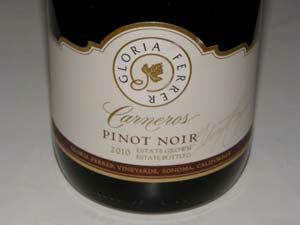 2010 Gloria Ferrer Estate Grown and Bottled Carneros Pinot Noir 13.5% alc., pH 3.65, TA 0.61, $18. Nineteenth Carneros Pinot Noir produced. 100% de-stemmed, partially crushed, exclusively free run juice, barrel aged 9 months in 33% new French oak barrels and bottled unfined. · Moderately dark reddish-purple color in the glass. Inviting aromas of oak-infused black cherries and a hint of dried herbs. Mid weight core of dark red cherry fruit with complimentary oak. A real cherry bomb that makes an impression on the mid palate and finishes intense and long. A very soothing, easy drinking wine and an incredible value. Very good.
2008 Gloria Ferrer Estate Jose S. Ferrer Selection Carneros Pinot Noir 13.8% alc., pH 3.83, TA 0.58, 538 cases, $40. A barrel selection from the most exceptional blocks in the estate vineyard. Primarily Dijon 115, Colmar 538, Trefethan/Wente, and Martini. 100% de-stemmed, aged for 9 months in 38% new French oak barrels. · Moderately dark reddish-purple color in the glass. Approach this wine with patience as it needs time to open in the glass, gradually becoming more expressive. Aromas of dark berries and cherries, spice and old wine cellar. Dense and dark, featuring earthbound flavors of black cherries, blackberries, black plum, mushroom and tar. Firm, balanced tannins and a very long finish. A brooding wine on day one, but two days later from a previously opened and re-corked bottle, the wine was transformed, becoming alive aromatically and more giving on the palate. Suggest decanting if you open this wine now. Very good.
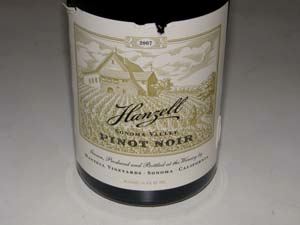 2007 Hanzell Vineyards Sonoma Valley Pinot Noir 14.4% alc., $80. 200- acre estate with 42 acres of vineyards planted to heritage clones. · Moderate reddish-purple color in the glass. Fresh aromas of dark berry tart, cassis, dark chocolate, and anise-laced oak. Very earthy and somewhat brooding with bruising tannins. Moderately richly flavored with dark berries, black cherries and anise. Much better the following day from a previously opened and re-corked bottle and especially good with beef that counteracts the tannins. This wine needs more time to integrate and soften the tannins but has a special rugged mountain character that is appealing. Very good.
2010 James Family Cellars Estate Grown Stony Point Vineyard Sonoma Coast Pinot Noir 14.3% alc., $36. Best of Class and Double Gold 2012 Sonoma County Harvest Fair. · Medium reddish-purple color in the glass. Appealing aromas of ripe Bing cherry pie glaze, cola and spice with oak that becomes more noticeable over time. Middleweight core of ripe cherries with hints of nutmeg and cherry cola, framed by silky, balanced tannins. A cherry bombast that has a little more oak topcoat than I prefer, but as indicated by the exalted competition award, this wine will definitely find fans. Good.
Kessler-Haak Vineyard is located on Highway 246, 11 miles west of Buellton in the cool northwestern section of the Sta. Rita Hills AVA. Planted in 2005 by winegrower and winemaker Dan Kessler and his wife Ellen Haak (“hawk”) Kessler, the 30-acre vineyard is planted to Pinot Noir and Chardonnay. A few select wineries also source grapes from the vineyard. The website is www.kesslerhaakwine.com.
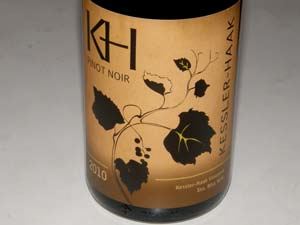 2010 Kessler-Haak Kessler-Haak Vineyard Sta. Rita Hills Pinot Noir 14.5% alc., 225 cases, $38. Yield 1.2 tons per acre. Clones 115, 667 and 777. Aged in 33% new French oak barrels for 9 months. Unfined. · Moderately dark reddish-purple color in the glass. Dusty earth and oak vanillin aromas compliment the spicy black raspberry nose. Moderately full bodied with flavorful dark red and black fruits, a sidecar of spice, and a good lick of citrus-driven acidity on the back end. Shows the intense fruit balanced with a firm structure and bright acidity so typical of Sta. Rita Hills Pinot Noir. Held up well over night from a previously opened and re-corked bottle. Very good.
2010 Kessler-Haak Kessler-Haak Vineyard Clone 2A Sta. Rita Hills Pinot Noir 14.1% alc., 50 cases, $42. Yield 0.7 tons per acre. Aged 9 months in neutral French oak barrels. Unfined. · Moderately dark reddish-purple color in the glass. Dark red and black cherry and berry preserve aromas and flavors are featured in a mid weight wine with muscular tannins and a good kick of acidity on the finish. A little smoother and less tannic the next day from a previously opened and re-corked bottle. For those who like their Pinot rugged and firm. Good.
2010 Kessler-Haak Kessler-Haak Vineyard Pommard Clone Sta. Rita Hills Pinot Noir 14.1% alc., 50 cases, $42. Aged 9 months in 50% new French oak barrels. Unfined. · The nose leads with aromas of deeply colored cherries and berries, plum sauce, beet root and dried rose petal. Striking black cherry flavor which expands in the mouth, picking up accents of spice along the way, finishing with a big kiss of cherry. Complimentary backbone of lively acidity and well-mannered tannins. I have said it many times and I will say it again: Pommard is my paramour (and the alliteration is pretty good too). Very good.
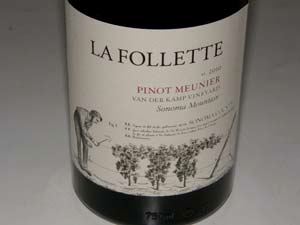 2010 La Follette Van Der Kamp Vineyard Sonoma Mountain Pinot Meunier 14.2% alc., 94 cases, $37. At 1400 feet, one of the oldest Pinot Meunier plantings in California. Whole cluster fermentation, raised 10 months in neutral French oak barrels. · Moderately light reddish-purple color in the glass. Rustic, very restrained aromas of dark raspberry, tobacco and tea leaves. Much more appealing on the palate with a hardy core of plum, black raspberry, black grape, cola and spice flavors with a faint note of smoke and tar in the background. Well-managed tannins with bright acidity on the finish where the fruit returns repeatedly for an encore. Good (+).
Pali Wine Co. launched a series of appellation Pinot Noirs beginning with the 2007 vintage that are moderately priced ($21 to $29). Five wines are offered in the 2011 vintage. The winemakers are Aaron Walker and consultant Kenneth Juhasz. The winery is located in Lompoc, but a tasting room opened in downtown Santa Barbara in the fall of 2012. The website is www.paliwineco.com.
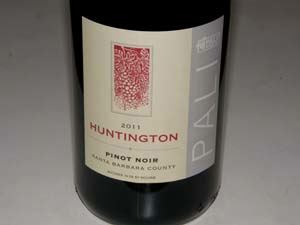 2011 Pali Wine Co. Huntington Santa Barbara County Pinot Noir 14.2% alc.,3,535 cases, $22.50, screwcap. Aged 10 months in 25% new French oak barrels. · Medium reddish-purple color in the glass. Nicely perfumed with staying power in the glass offering aromas of very ripe black cherries, black raspberries, cola and spice. Upfront appeal with flavorful black cherry, dark berry and tea tastes backed by supple tannins. Nothing exceptional, but solid. Good (+).
2011 Pali Wine Co. Summit Sta. Rita Hills Pinot Noir 14.6% alc., 1,020 cases, $29, screwcap. Aged 10 months in 30% new French oak barrels. · Moderate reddish-purple color in the glass. Enticing aromas of earth-kissed dark red and black berries, tea leaves and rose petals. Flavorful mix of purple berries with a hint of oak in the background. Modest tannins, a soft texture and a relatively short finish. A basic, very quaffable, fruity wine. Decent.
2010 Sean Minor Carneros Pinot Noir 13.5% alc., $14. · Moderately dark reddish-purple color in the glass. Earthy black fruit on the nose which is very shy. Somewhat rich flavors of red and black plum with a hint of spice and oak. The wine has a silky presence on the palate with good tannic spine and a refreshing cut of acidity on the finish. A pleasant drink and solid for its price range. Decent.
Tuck Beckstoffer is well known for the many notable Napa Valley vineyards that bear his family name. Tuck is a lover of Burgundy and makes a small amount of Pinot Noir and Chardonnay from the Sonoma Coast under the Semper label. The consulting winemaker is Kenneth Juhasz (Auteur). Honestly, these wines are not my preferred style of Pinot Noir. They have oodles of flashy fruit, and are unabashedly macho, akin to Syrah without the tannins. That said, they will find fans among those who like big-fruited wines that have “Made in California” stamped all over them.
2009 Semper Silver Eagle Vineyard Sonoma Coast Pinot Noir 14.2% alc., $85. Vineyard grower and owner is Ulises Valdez. Planted to Calera selection and a Vosne-Romanée selection. · Very dark purple color in the glass. Bright aromas of ripe plum and black raspberry with a hint of graham, losing some appeal over time in the glass. Soft and seductive on the palate with prodigious fruit expression, finishing with an intense peacock tail of fruit that lingers. Flavors of black cherries, black raspberries and dark chocolate are featured and the juicy acidity brings some vibrancy to the wine. Tasted two days later from a previously opened and re-corked bottle, the wine tasted of very ripe fruit, and was not as appealing. Made for consumption now. Good.
 2009 Semper Ellenbach Vineyard Sonoma Coast Pinot Noir 14.7% alc., $85. This vineyard is located just above the fog line just two miles in from the Pacific Ocean in the far northwestern corner of the Sonoma Coast AVA. · Dark purple color in the glass. The nose is appealing initially with aromas of dark berry jam, forest floor and oak. Over time, porto notes creep in. Full-bodied core of black plum, boysenberry and black currant fruit which veers to the far ripe side. The tannins are well-managed, the wine drinks effortlessly, and the finish is monstrous. Good.
2009 Semper Gold Ridge Vineyard Russian River Valley Pinot Noir 14.4% alc., $85. This vineyard is named for a vein of gold loam soil running from the western edge of the Russian River towards the town of Annapolis on the Sonoma Coast. · Moderately dark reddish-purple color in the glass. Demure aromas of black cherries, dark chocolate, graham and wood shavings. Amazingly intense and sappy fruit presence which coats the mouth and fuels a big, long finish. Flavors of black plum, black cherry and blueberry with an earthy, mineral undertone. Tasted two days later from a previous opened and re-corked bottle, the nose had checked out and the wine was flat. Good.
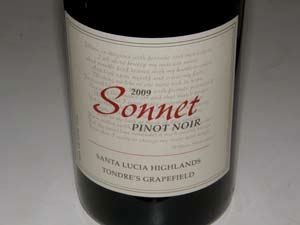 2009 Sonnet Tondre’s Grapefield Santa Lucia Highlands Pinot Noir 14.5% alc., $25. · Moderately dark reddish-purple color in the glass. Nicely perfumed with the scent of black stone fruit, black current, cardamon spice and vanilla. Full-bodied and velvety on the palate with dark red and black fruit flavors with a compliment of spice and cola. No intruding tannins, a soft and sensuous mouth feel, and a crisp finish with good staying power. Very good.
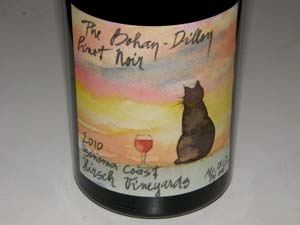 2010 The Bohan-Dillon Hirsch Vineyards Sonoma Coast Pinot Noir 13.1% alc., $28. · Light reddish-purple color in the glass. Aromas of cranberries, alpine strawberries, raspberries, spice, oak and forest floor. Delicate but pleasing red fruit flavors including pomegranate with a hint of baking spice, and a thrust of citrus peel acidity on the tangy, crisp finish. Very supple tannins make for a satisfying daily drinker. Good.
2011 Waxwing Spring Hill Ranch & Vineyard Sonoma Coast Pinot Noir 12.1% alc., 97 cases, $33. Released early 2013. 15% whole cluster. Aged 10 months in 30% new French oak barrels. From a very cool site in the Petaluma Gap. Pommard, 115, Swan and Calera clones. · Light reddish color in the glass. Restrained aromas of spiced cherry, smoky oak and rose petals. Lean flavors of red cranberries and cherries with a grip of green tea, leaf and tar. Light on its feet with nervy acidity, leaving a little deep cherry flavor behind on the finish. The fruit in this wine appears to have struggled to get ripe, and although the winemaker did admirably with the hand he was dealt, this is an austere wine. Decent.
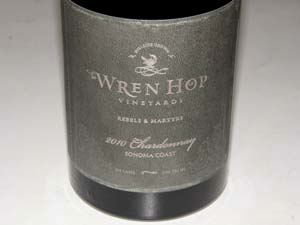 2010 Wren Hop Vineyards Rebel & Martyrs Sonoma Coast Chardonnay 14.5% alc., pH 3.43, 165 cases, $48. Sourced from Sun Chase Vineyard, located where the Petaluma Gap joins with Sonoma Mountain at an elevation of 900 to 1400 feet on a southwestern facing hillside. Dijon clone 96. Aged 11 months in 100% new French oak barrels. · Light straw color with a very slight haze in the glass. Shy aromas of citrus, wet stone and dried seeds. Dry, soft and smooth on the palate, offering more nutty, yeasty and toasty flavor than pear and citrus fruit. Still, a refreshing wine with admirable acidity that finishes clean and bright. Good.
2010 Wren Hop Vineyards Trial by Lightning Sonoma Coast Chardonnay 14.4% alc., pH 3.47, 325 cases, $48. Sourced from Gap’s Crown Vineyard, located on the western edge of Sonoma Mountain. Dijon clone 76. Aged 11 months in 100% new French oak barrels. · Light straw color with a very faint haze in the glass. Delicate aromas of lemon curd, buttered toast, and spice. The wine has an appealing steeliness to invigorate the lemon, lime and baked pear flavors. Oak jumps in to offer notes of maple syrup, almonds, toast and marshmallow. Good (+).
Oregon Blockbuster to Beauty MovementWatershed, a Portland-based brand communication specialist, recently sent me a case of wine to sample. Labeled the “Best Case Scenario,” First Edition, Winter ’12/’13, the twelve wines are said to be part of an evolving style of Oregon Pinot Noir termed “From Blockbuster to Beauty.” The idea is that there are many Oregon Pinot Noir wines in production “that are elegant, bright, energetic, balanced, pretty, and under 14% alcohol.” This is a push-back to the popularity in recent years of opulent, blockbuster wines that have garnered big scores, collected wine competition medals, and caught the public’s palate. For many wineries, their alternative style of Pinot Noir offers nuance, expression of site, and food-friendliness without sacrificing intensity of flavor needs to find a voice in the marketplace. Sound familiar? Read the first article in this issue on a California organization, In Pursuit of Balance, which is tooting the same horn. This case of wine reviewed here was meant to illustrate this movement, a renaissance of sorts, in which hopefully an alternative style of elegant and nuanced, bright and juicy Pinot Noir will gain recognition and desirability in the marketplace. I say a renaissance of sorts, only because there are some producers in Oregon such as The Eyrie Vineyards that have been producing this style of Pinot Noir for many years so the style is not new. It is the attempt to publicize and promote it on a large scale that is new. The Oregon wines in this case are not going to please the palate of those reared on California Pinot Noir of the Kosta Browne, Belle Glos, Williams Selyem, and Sea Smoke genre. Those producers will never go out of favor because they offer a captivating style of Pinot Noir that garners deserved attention. I say buy a few of these Oregon wines reviewed here or similar ones in style, and contrast them with some of the more powerfully fruity style of Pinot Noir wines, and decide what pleases you the most. You won’t find any of these Oregon wines reviewed here receiving high scores from the wine press, so let your own palate decide. Unfortunately, this movement has been launched to coincide with the release of the 2010 and 2011 vintage wines, two of the most challenging in Oregon’s recent modern wine history. I am all for elegance and restraint in Pinot Noir, but a number of the wines reviewed here are just too austere for my liking. The 2012 vintage should provide a much better platform for this movement’s voice. this.fmt_tasting_notes(5900,5901,5902,5903,5801,5614,5904,5905,5803,5906,5907,5908): 5905 An Oregon wine I received recently for review that really fits the “Beauty Movement.”
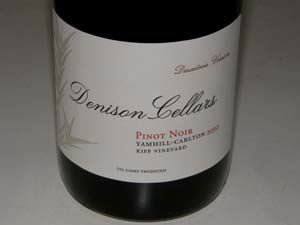 2010 Denison Cellars Kiff Vineyard Yamhill-Carlton District Willamette Valley Pinot Noir 13.7% alc., pH 3.62, TA 0.52, 125 cases, $38, screwcap. 667, 777 and Pommard clones. Aged 12 months in 335 new French oak barrels. Unfined and unfiltered. Winemaker Tim Wilson. Vineyard farmed by Joel Kiff. · Moderately light reddish-purple color in the glass. The nose displays an appealing marriage of black cherries and oak. Fresh, bright and flavorful, featuring black raspberry and black cherry fruit with a slight touch of peppery spice. Moderately rich with balanced, soft, dry tannins, and some length on the generous finish. This wine also has some textural interest and is beautifully crafted. Very good.
One more noteworthy Oregon wine.
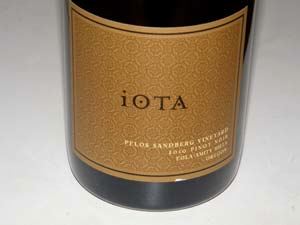 2010 iOTA Pelos Sandberg Vineyard Eola-Amity Hills Willamette Valley Pinot Noir 12.9% alc., 402cases, $38. Pommard, Wädenswil, and Dijon 667, 777 from six estate vineyard blocks. Aged 10 months in 47% new French oak barrels and an additional year of bottle aging before release. Unfined and unfiltered. · Moderately dark reddish-purple color in the glass. Intense black cherry, plum and spice aromas with a hint of toasty, cedary oak. Discreetly concentrated flavors of smoky black cherry and dark raspberry fruit robed in balanced, dry tannins, finishing with an infusion of black raspberry jam on toast. There is a little more oak talking at present than I prefer, but this should integrate further with another year in bottle. Good.
Pinot BriefsOregon Pinot Noir Off To South Korea The Portland Business Journal (February 14, 2013) reported that a cadre of South Koreans visited Oregon wineries and bought 2,200 cases and have been shipped to Shinsegae, South Korea’s largest retailer, which operates supermarkets similar to Fred Meyer. The wines are from Domaine Drouhin Oregon, Lange Estate Winery & Vineyards, WillaKenzie Estate, and Union Wine Company. Wine consumption is increasing in South Korea and wine is the preferred alcoholic drink for women in Korea because it is perceived as healthy. This popularity of Oregon wine abroad comes as no surprise as latest figures show that United States wine exports are poised to set a record $1.4 billion in 2012. According to the Wine Institute, wine exports increased 2.6% for the third straight year. 90% of the exports are from California wine regions. Europe is the top market for California wines with Canada second. Sales in China zoomed 18% to $74 million, while South Korea had a 26% gain to $16 million. Many stateside wineries find it is easier to ship wine abroad than try to deal with the maze of individual state restrictions on shipping wine. For American Pinot Noir lovers the news is not necessarily good, as there will be more competition for top bottlings in the future. It is curious that American wineries are sending plenty of wine abroad when in this country there are still over 108 million people potential customers who are not drinking wine regularly. According to Andrew Jefford (Decanter.com, January 28, 2013), between 16 and 20 percent of United States citizens consume 90% to 96% of the wine. Wine Business.com (January 21, 2013) reports that the “core” drinkers account for 93 percent of the 175 million cases of wine sold off-premise in 2012. The largest number and most frequent buyers are Baby Boomers (ages 49 to 67) and Millenials (ages 19 to 36). Ekton is the Second Sub-AVA for Umpqua Valley Wines & Vines (February 14, 2013) reported that effective March 7, 2013, the new Ekton Oregon AVA has been approved. The AVA consists of 74,900 acres within the Umpqua Valley AVA and the larger Southern Oregon AVA, and is planted to only 96.5 acres of grapes currently. The new AVA is separated from the rest of the Umpqua Valley by a ridge of low-lying hills that contain the cold maritime air from the Pacific Ocean only 30 miles away, making this new AVA cooler than the rest of the Umpqua Valley. River’s Edge Winery and Brandborg Vineyard & Winery grow Pinot Noir in the new Ekton AVA. Others are exploring the possibilities for Pinot Noir is this relatively undeveloped region that has plantings dating back forty years. The other sub-AVA in the Umpqua Valley is Red Hill Douglas County Oregon AVA which was approved in 2005 ( one winery, 5,500 acres). Rollin Soles Leaves Argyle for ROCO The along time (since 1987) winemaker at Argyle Winery is leaving to concentrate on the label he established ten years ago with his wife Corby Stonebreaker-Soles. Soles’ assistant winemaker, Nate Klostermann, will take over for Soles at Argyle. ROCO produced 4,000 cases in 2012 from both purchased fruit (a Willamette Valley and a Maresh Vineyard bottling) and estate fruit (“Private Stash” from the 7-acre Wit’s End Vineyard that the Soles own). The estate vineyard was planted in 2001. A tasting room is now open adjacent the winery on Red Hills Road in Dundee. No word on whether he will make sparkling wines, which were Oregon’s finest at Argyle.
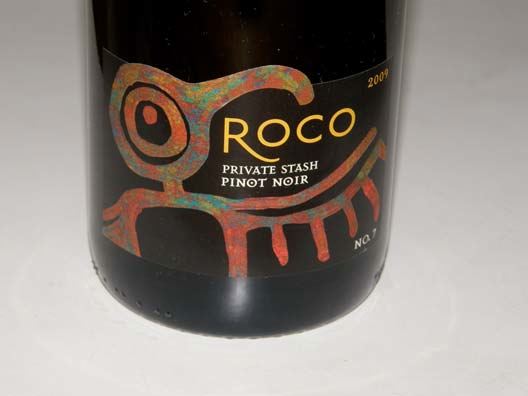 Presqu’ile Joins Wilson Daniels Presq’uile Winery has joined Wilson Daniels’ portfolio and will be the winery’s distributor beginning in 2013. Two generations of Murphys oversee this family winery, joined by winemaker Dieter Cronje and vineyard manager Jim Stollberg. Presqu’ile is creole for “almost an island,” named in honor of the Murphy’s beloved family gathering place located on the Gulf Coast that was destroyed by Hurricane Katrina. Presq’uile property includes 73 acres of certified sustainably farmed vineyards on 200 acres with a modern gravity-fed winery. Presq’uile currently produces Pinot Noir, Chardonnay, Syrah and Sauvignon Blanc. No More “Two Buck Chuck” Trader Joe’s has sold millions of cases of “Two Buck Chuck” over the past 11 years but recently the price has gone up. Stores in California increased the price from $1.99 to $2.49, making it now “Two and a Half Buck Chuck.” Heat During Shipping Shortens Potential Bottle Age A recent Purdue University study (“Effects of heat exposure on wine quality during transport and storage,” Journal of Wine Research, 23:1, 2012) monitored the exposure of wine to heat during shipments through the national distribution network from wineries. During the summer and early autumn months, wines shipped to or via warm geographic regions were often exposed to temperatures above 75ºF and frequently for extended periods of time. In some cases, wines would have been exposed to extreme temperatures of up to 111ºF. Also, frequent large diurnal variation (39ºF to 70ºF) were found. Using ethyl carbamate formation to determine accumulated heat exposure as a wine quality indicator and different kinetic models for wine aging, the researchers suggested that some wines exposed to heat during transport corresponded to an added bottle age of between 1 and 18 months compared with conventional cellar storage. Surf City Vintners Wine University Pinot Noir Appreciation Class On March 10, 2013, Joe Miller of Rexford Winery will present a class titled, “Santa Cruz Mountain Pinot Noir: On the World Stage.” Miller will explore the influence of location on the qualities and characteristics of Pinot Noir, discover why the Santa Cruz Mountains is among the world’s best regions for Pinot Noir, and sample local Pinot Noirs compared with a French Burgundy. Joe Miller taught UCSC Extension classes on wines of Burgundy for many years. Attendees will receive a “diploma” in Sip-ology from Surf City University. The class is $30. Register at the Surf City winery tasting rooms or call 408-234-2079. A Chardonnay class, “Chardonnay Styles,” with Steve Storrs of Storrs Winery will be held in April. The dozen boutique wineries and tasting rooms that make up the Surf City Vintners offer an urban wine tasting experience in renovated warehouses. Visit the website at www.surfcityvintners.com. Affairs of the Vine Pinot Noir Summit The 11th Annual Pinot Noir Summit will be held Saturday, March 16, 2013, at the Herbst at the Presidio in San Francisco. The 40 wines offered for blind judging by the public have been reviewed by at least two tasting panels, and the results are compared to those of a panel of experts in this year’s Pinot Noir Shootout. The Pinot Noirs hail from California, Oregon and beyond. The event includes workshops and a Grand Awards Tasting & Ceremony. Use discount code, “pinotfan,” for a discount on tickets before February 28. Visit www.brownpapertickets.com to view the event schedule and to purchase tickets. La Follette Wines at The Barlow Grand Opening The Barlow in Sebastopol, a marketplace that brings together winemakers, brewers, artisan food producers and artists, has finished construction and several of the winery tasting rooms will be holding Open Houses. La Follette Wines Grand Opening, the Pinot and Popcorn Terroir Tour, will be held March 16, 2013. Greg La Follette and assistant winemaker Simone Sequeria will be hosting three seated flights of tasting pairing La Follette wines with different flavors of popcorn while exploring the various vineyard sites in the La Follette portfolio. Greg will also serenade guests with his bagpipes. The seated sessions are complimentary but reservations are required. Contact Jana Churich at 707-395-3902x224 or jana@lafollettewines.com. The tasting room will be open from 11:00 to 6:00 that day to welcome all. Wine World iPhone App Catalan entrepreneurs launched the first iPhone app with worldwide information about wine. The app supplies information about 983 wine regions of 17 of the main producing countries, including information on every wine region such as its kind of grapes, types of wine, production, and shows the user the closest wine stores. World Wine contains a database of more than 29,000 wine cellars and stores from 61 countries. In updates to follow, World Wine will include assessment and opinions about different kinds of wines. The information is available offline as well. Offered by WasabiLabs at www.wasabilabls.eu. La Dolce Vita Wine Lounge This charming wine bar is located in downtown Petaluma across the street from Boulevard Cinemas in Theatre Square. In keeping with its location, La Dolce Vita Wine Lounge shows movies on the wall behind the bar from the owner’s collection of classic DVDs. Owner Sahar Gharai started this business in 2007. The wine menu is organized into flights and a food menu of small plates is offered to accompany the wines. A reader, C.J. Newton, told my about this place and submitted the following photo of the Wine Wall at La Dolce Vita Wine Lounge. Outdoor seating is available as well. Highly recommended by several reviewers in tripadvisor. Visit www.ldvwine.com for hours and further information.
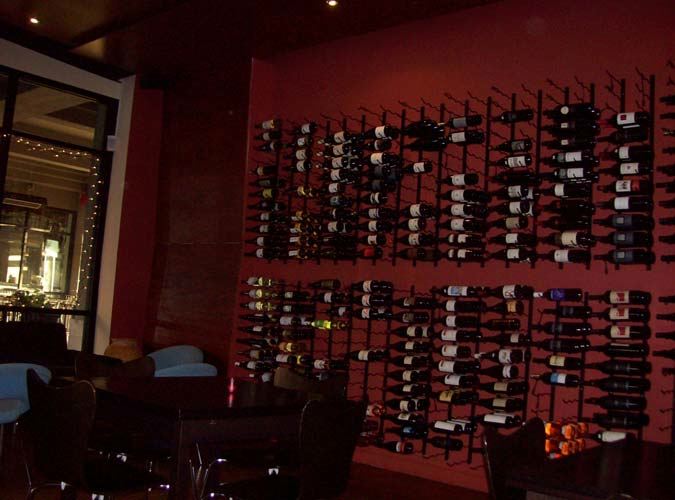 Kegs and Growlers Gain Popularity in Oregon According to an article in Wines & Vines January 23, 2013), House Bill 2443 is aimed at allowing consumers to receive wine, beer and cider in “securely covered containers” no larger than 2 gallons at restaurants and grocery stores. This will allow wine drinkers to source wines when they live some distance from a winery, allowing them to refill growlers locally much like you would fill up your car with fuel. Currently, consumers can only fill containers at wineries. Refillable kegs have become popular with several wineries in Oregon since 2009. 7,498 Wineries Now in the U.S. A report from Wine Business Monthly (February 2013) proprietary database, part of the Review of The Industry issue, found that the total number of wineries in the U.S. is now 7,498, an increase of 102 wineries over last year (the smallest growth in the past four years). The number of wineries for California was 3,532, Washington 670, Oregon 543, and New York 306. Record Winegrape Crush in 2012 As I travel around, winemakers are stoked about the abundant harvest in 2013. Many report yields up 45% over last year, but beyond the generous yields, the quality is very high as well. Some are saying 2012 is the best ever vintage for the West Coast. The California Agricultural Statistic Service, CDFA, California Preliminary Grape Crush Report said that the 2012 crush totaled a record high 4,383,100 tons, up 13 percent from the 2011 crush and 1 percent larger than the previous record high 2005 crush. Chardonnay accounted for 16.8% of the crush, Cabernet Sauvignon 11.3%, Zinfandel 10.3%, Merlot 7.6%, French Colombard 7.1% and Pinot Noir 5.6%. A total of 247,303.1 tons of Pinot Noir were crushed compared to 170,450.1 tons in 2011. Weighted average degrees Brix for Pinot Noir was 24.5 for the state compared to 24.0 in 2011. Wholesale average base price for Pinot Noir was $2,688.02. Soledad in the Salinas Valley Looking for Wine Tourists The Los Angeles Times (February 17, 2013) reported that the farm town of Soledad is reaching out to tourists to stop and explore the area with a billboard that says, “Soledad: Feel the Momemtum.” The Pinnacles National Monument is located five miles east of Soledad in the Gavilan Mountains. 12 well-regarded Monterey County wineries sit within five miles of Soledad, providing the opportunity for wine tasting rous and The Pinnacles National Park tours. Calera Wine Company, located in Hollister, and somewhat isolated, is near Soledad and appealingly off the trodden parth. It has a tasting room open daily from 11:00 to 4:30. The oldest producing vineyard in Monterey County, Chalone Vineyard Estate, is located on the Gavilan Mountain Range but is not open to the public. Visit www.citeofsoledad.com or www.gatewaytopinnacles.com. Pinot In The Windy City Over 60 Willamette Valley wineries will converge on Chicago on March 7 to pour their wines. The event will take place at City Winery in the heart of downtown Chicago. The Willamette Valley Wineries Association (WVWA) are promoting this trade show and are in the middle of a “Drink Pinot, Think Oregon,” campaign. Visit www.willamettewines.com for information and tickets.
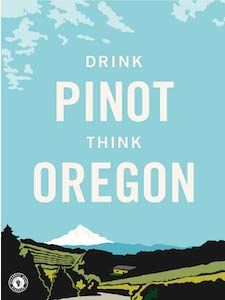 Pinot Noir Leaf Curl Discussed at Sonoma County Grape Day Event Wines & Vines online (February 21, 2013) reported that Pinot Leaf Curl, which was rampant in Sonoma County in the cool vintages of 2010 and 2011, has been found to be a nitrogen disorder leading to the vine producing a toxic compound known as putrescine. Severe cases can stunt shoots and decrease yields. The condition was much less evident in 2012. The most important cause appears to be the vineyard location and the minimum daily spring temperatures. Pill to Counteract Alcohol Daily Mail Online (February 18, 2013) detailed research at UCLA that has developed a cocktail of alcohol metabolizing enzymes that quickly reduced blood alcohol levels in inebriated mice and allowed them to sober up much quicker compared to mice that did not receive the enzyme treatment. The results are very preliminary and human trials are a ways off, but this could lead to an alcohol ‘antidote’ pill that would accelerate alcohol metabolism in the stomach and avoid drunkenness. The researchers are also developing a pill that destroys the substance that produces male pattern baldness.
Alarming Study on Alcohol and Cancer Death Risk Should Not be Alarming
A study was published online February 14, 2013, in the American Journal of Public Health by Nelson, DE et al, in advance of print titled, “Alcohol-Attributable Cancer Deaths and Years of Potential Life Lost in the United States.” The lay press picked up this study and a published summary appeared the following day in the San Francisco Chronicle and soon after in The Seattle Times with an alarming title, “Alcohol use raises the risk of cancer deaths.” NBCNews.com released a report on February 18 with the alarming heading, “Even a drink a day boosts cancer death risk, alcohol study finds.” The research attempted to provide current estimates of alcohol-attributable cancer mortality and years of potential lost (YPL) in the United States. The researchers based their conclusions on relative risks found on meta-analyses published since 2000 and on adult alcohol consumption using the 2009-2010 National Alcohol Survey and other major alcohol epidemiologic databases. The study concluded that 18,200 to 21,300 cancer deaths (3.2% to 3.7%) of all United States cancer deaths were due to alcohol consumption. Breast cancer deaths were more common in women and upper airway and esophageal cancer deaths were more common in men. Deaths attributable to cancers result in 17.0 to 19.1 YPL for each death. Daily consumption of less than or equal to 1.5 drinks of alcoholic beverages led to 26% to 35% of alcohol-attributable cancer deaths. The authors of the study concluded, “Higher consumption increases the risk but there is no safe threshold for alcohol and cancer risk. What the Public didn’t read and needs to understand: R, Curtis Ellison, MD, Professor of Medicine & Public Health at the Boston University School of Medicine and Co-Director, International Scientific Forum on Alcohol Research, is a recognized expert in the science and epidemiology of the relationship between alcohol and health. In his comments on the published research at www.bu.edu/alcohol-forum/reviews, he points out a number of concerns about the analyses and conclusions made by the authors of this paper. Here are his important comments. “The authors do not clearly separate the effects of truly moderate drinking from heavier drinking in their conclusions. They do not take into account the pattern of drinking. They do not point out the demonstrated effects of alcohol on total mortality. The authors do not put their results into perspective: in other words, statements such as “There is no safe threshold for alcohol and cancer risk” is more of a ‘scare’ statement than a balanced discussion of their results. Given that almost all prospective studies show that regular moderate drinkers have better health as they age and live longer than abstainers, even papers focused on the effects of alcohol on any particular disease should present a balanced view on its net effects on health and disease. Observational data can never reveal the full ‘truth’ about the causation of disease from exposures.” Ellison emphasizes what the authors failed to mention in their paper, namely, “There has been a huge amount of previous research in this field, but the authors do not put their own results into prospective or discuss the overall health effects of alcohol consumption. Previous data have clearly shown that regular moderate drinkers tend to have lower risk of cardiovascular disease, stroke, diabetes, and many other diseases, and have a lower overall risk of all-cause mortality. As I have pointed out many times in the PinotFile, there are many challenges to medical research on alcohol in the United States and attempts to spread the correct communiqué to the American public. There are far too many alarming headlines implicating alcohol as evil and deadly, often under the veil of Neo-prohibitionism, resulting in a confusing message to the public. I believe we need more voices among the wine industry and many wine organizations, promoting the truth about responsible consumption of alcohol and wine and the resulting possible health benefits. Respected wine columnist, Dan Berger, recently wrote an article on “Scare stories about wine” for the Press Democrat (February 20, 2013) and pointed out that Andre Tchelistcheff lived to 92, Ernest Gallo to 97 and Robert Mondavi to 94. What does that tell you? |